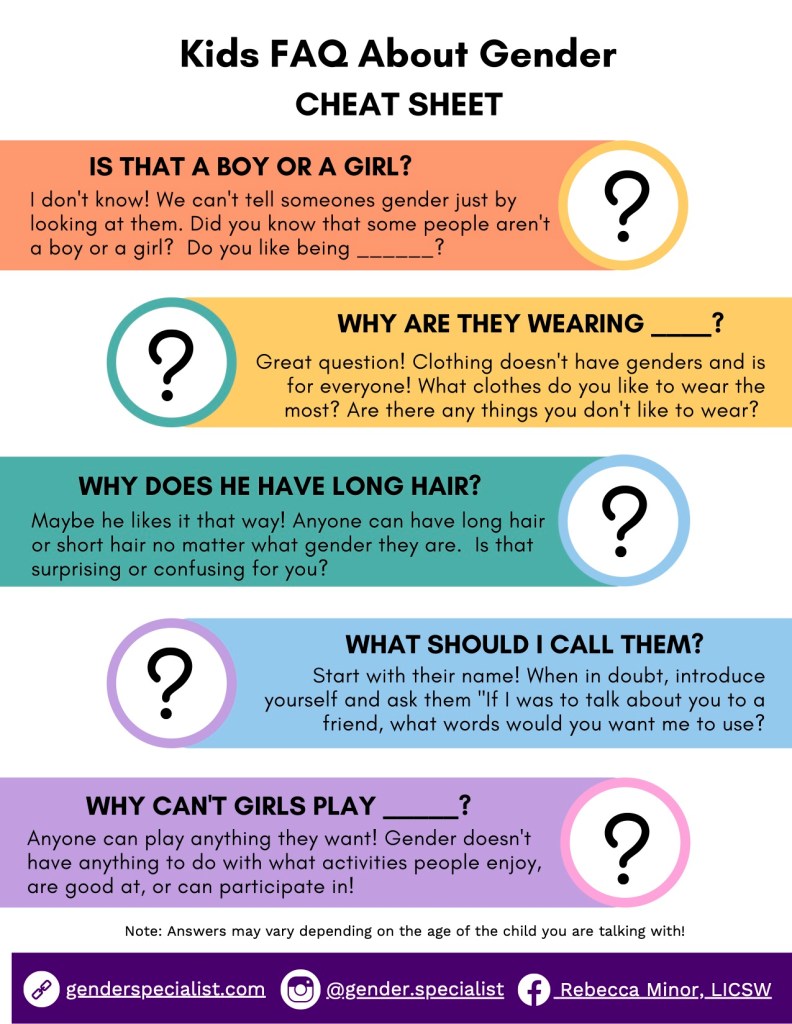The number of youth that identifies as transgender has doubled in recent years, according to a new CDC report. In 2021, data showed more than 1.2 million LGBTQ adults identified as non-binary.
Tony Ferraiolo didn’t have the words to describe who he was until his friend brought over a documentary on transgender people. He now understands he is a trans man and works with LGBTQ+ youth and their families.
Ferraiolo says that it’s essential for parents to teach their children kindness and give them words to express how they or their friends may identify.
“Kindness has a boomerang effect,” says Ferraiolo, the director of Health Care Advocates International’s Youth & Family Programs and a trans man. “When we are kind to others, we are kinder to ourselves, and when we are kind to ourselves, we are kinder to others.”
This is how to explain gender identity terms to grade-school children.

Gender identity terms to know (and how to teach them to your child)
The first step is to learn the lingo. Rebecca Minor, MSW, LICSW, a queer Jewish clinician and part-time faculty member at Boston University specializing in the intersection of trauma, gender, and sexuality, says, “It’s easy to get overwhelmed when we feel like we don’t understand. Learning the terminology of gender will make it much easier to communicate.”
Minor partners with trans and gender-nonconforming youth through their journeys and also offers coaching for parents of LGBTQ youth and an online class called How to Talk to Kids About Gender: Essentials for Parents & Caregivers, to help folks have conversations that matter.
These nine common terms often come up in discussions about gender identity. Here’s how to teach your child what they mean.
Sex
Ferraiolo suggests telling children, “Sex is a label that the doctor gives to a baby when they look at the baby’s body. For example, if the doctor sees a penis, that baby is labeled male. If the doctor sees a vagina, that baby is labeled female.”
This definition puts the initial gender assignment on the doctor, not the individual.
By grade school, your child likely has language for genitals. Using the correct terms normalizes the discussion of body parts.
Gender identity
Parents can also use doctors and birth to explain gender identity.
Ferraiolo advises parents to tell kids, “When a baby is born, a doctor looks at their body and assigns their gender identity. Once that baby is old enough, they tell adults if they were assigned the right gender identity or not.”
Minor agrees, adding, “I advise parents and caregivers to say something like ‘When babies are born, the doctors/nurses/midwives take their best guess about whether or not the baby is a boy or a girl based on body parts, and often times, they are right, but sometimes they are wrong. When the baby grows up and can say what their own gender is, that’s when we really learn who they are.'”
Gender expression
“This term refers to how the world sees you…it’s your outward appearance,” Ferraiolo explains.
Ferraiolo recommends giving examples of ways someone might show their gender expression, such as hairstyles or clothing.
Cisgender (Cis)
Now, you can build off your child’s knowledge of sex, how doctors assign sex at birth, and gender expression. Ferraiolo recommends saying, “A cisgender person is someone whose sex, gender identity, and gender expression matches the one assigned to them at birth, regardless of their sexual orientation.”
If your child does not know what sexual orientation means, Ferraiolo suggests defending it as, “who you find yourself attracted to. You can’t choose your sexual orientation. It is held in your heart.”
Transgender (Trans)
Ferraiolo says parents can use similar language to explain transgender to children. Try, “A transgender (trans) person is someone who has a different sex, gender identity, and/or gender expression than the one assigned to them at birth, regardless of their sexual orientation.”
Non-binary
For years, people felt forced to choose between two options, male or female. As society learns more about gender, the term non-binary is becoming more prevalent, giving individuals a better way to describe themselves authentically.
To explain non-binary to a child, Ferraiolo says parents can say, “Non-binary gender is any gender that isn’t only (exclusively) male or female. Non-binary people may feel some mix of both male and female, somewhere in between, or something completely different.”
Gender-fluid
Gender is a spectrum. Ferraiolo says school-aged children will likely understand a parent if they say, “Gender fluid individuals recognize that their expression and gender identity alters between male and female.”
Social transition
Ferraiolo suggests that parents define social transition as, “The outward change in appearance and/or presentation that a transgender or non-binary person may undergo in order to express their gender identity.”
Examples of a social transition may include a name and pronoun change.
Medical transition
Ferraiolo says parents can tell children that people undergoing medical transition undergo medical interventions to affirm their gender identity.
Support is another word for affirm if the child is confused.
Ferraiolo asks parents to explain that it’s never OK to ask someone if they have undergone a medical transition.
“As a trans man, I’ve been asked about my genitalia more than most have been asked, ‘How’s your day going?’” he says. “It is inappropriate and should never be asked.”
Instead, Ferraiolo suggests people ask, “What does your gender journey look like for you?”
“This gives them the space to share what they feel comfortable sharing,” he says.
Tips for raising kids who are knowledgeable about gender identity
Minor offers some tips to guide parents through these important talks.
Not saying anything is far worse than saying the “wrong” thing
“I see a lack of confidence and fear preventing a lot of parents and caregivers from engaging in conversation,” Minor says. “We owe it to the children we care for to arm ourselves with the knowledge, tools, and awareness to care for them beyond the limitations of the gender binary.”
Give your child time to understand and ask questions
“Pause to allow the child to have time to process and ask questions. It can be helpful to use examples of people you know or characters they like from books or movies to illustrate your point,” Minor says.
Be mindful of how you talk about the world outside of these conversations
“It’s important to pay close attention to the things you’ve been socialized to say, like ‘man up,’ ‘boys don’t cry,’ ‘be more ladylike,’ and ‘you throw like a girl,’ Minor says. “Kids are listening and learning from us all the time. Normalize the use of ‘they’ pronouns by introducing them just as kids are taught ‘he’ and ‘she.’ Try to use gender-neutral terms like ‘friends,’ ‘guests,’ and ‘everyone,’ instead of ‘boys and girls.’
Consider the types of toys your child plays with
“Dress-up, pretend play, and allowing opportunities for play with gender-typed and gender-neutral toys are great ways to start,” Minor says. “Researchers have found that neutral or moderately gender-typed toys foster optimal development because they tend to promote more types of cognitive, academic, spatial, physical, musical, and artistic skills. Alternatively, gender-typed toys can be a wonderful opportunity for gender exploration and are an essential part of the development process for all children.”
Remember this should be an ongoing conversation — not a one-time talk
“Expose them to all kinds of people and provide opportunities to explore beyond the limitations of the gender binary,” Minor says. “Let go of the idea that you will be able to address these topics all at once. Talks about gender and sexuality should be ongoing topics of conversation in the home. These don’t have to be sit-down serious conversations but can be brief commentary or a response to things you see and experience together.”
There are also some common questions kids have about gender identity, and Minor provided a helpful “cheat sheet” for parents:

Why it’s essential to teach your children about gender identity
Studies show transgender youth are more likely to attempt or die by suicide. They are also more likely to be bullied. Education can help bring about greater understanding, kindness, and support for children who are not cisgender. This acceptance can be life-saving.
“I can’t tell you how many times I am sitting in front of a young trans or non-binary person who is sitting in a psych ward because they either have attempted suicide or have suicidal ideations, and it’s not because they are trans or nonbinary, it’s because the people in their lives are not supporting them,” Ferraiolo says.

Summing up gender identity and youth
There are age-appropriate ways to discuss sex, sexuality, and gender identity with your grade-school child, and these discussions benefit them and others. Giving children the language to describe gender identity can create better awareness and understanding. It can also lead to more support for gender non-conforming youth. If you’re struggling to find the right words, books might help. Ultimately, Ferraiolo says leading with kindness is essential.
“What is important is to express to your children that no matter who they are, it is OK,” Ferraiolo says. “Sometimes we will meet people who are very different, and that’s OK. Remind them that kindness is most important.”
Minor agrees: “Know that you do not have to have all the answers, and you can be honest with your child when you don’t know something. You can always communicate that you love and affirm people regardless of how they identify or express themselves. Make it clear to your kids from an early age that your family values, and the communities you are a part of, are inclusive and affirming.”




